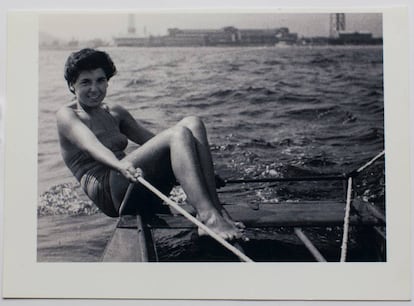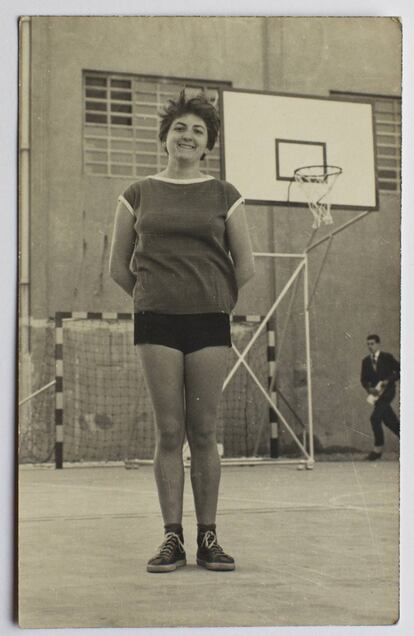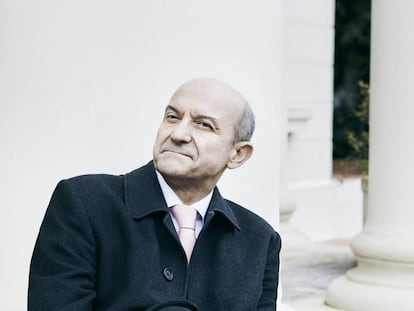The female pioneers of Spanish sports
It took effort and ingenuity to work around the strict guidelines set by Spanish National Catholicism under Franco, but these women managed to blaze a trail in the history of sports in Spain. Even today, they continue to set the standard
“Champions! Champions!” chant these spry and spontaneous women – the champions of female sports in Spain in an era of repression. Each was a pioneer in her field, like alpine climber Carme Romeu, basketball player Encarna Hernández, gymnast Goyita Postigo, tennis players Pilar Barril and Alícia Guri and open water swimmer Montserrat Tresserras.
EL PAÍS managed to bring them together in tribute to all the courageous and determined women involved in competitive sports during the dictatorship. Challenging the moral dictates of the Falange, Spain’s only political party at the time, and its Women’s Section, they got around the pervasive “gender thing” to achieve “things that women couldn’t do” – in the words of 104-year-old sportswoman Josefina González, who has known three forms of government: monarchy, republic and dictatorship.

Their experiences have been compiled in Women, Sports and Dictatorship (1939-1975) – an R&D project undertaken by eight Spanish universities and coordinated by Xavier Pujadas, from the Ramon Llull University in Barcelona. The study reveals the multiple obstacles that once faced female athletes who strayed from the Falange’s guidelines. Although the Women’s Section introduced physical exercise to regions of Spain unfamiliar with it, the idea of sports followed the edicts of Spanish National Catholicism.
Female soccer player Dolors Ribalta, who worked on the project, says: “The Women’s Section’s medical, religious and political theories defined the feminine ideal as a home-based, maternal and caring sort that was a far cry from the female athlete.”
Like many other young sportswomen, the swimmer Elsa Verdugo remembers being chided from the pulpit at church. To escape the pressure, some sportswomen either moved school or gave up their chosen sport. Those involved in water sports, such as swimming, diving, synchronized swimming and open water swimming, suffered the most.
Still active today, these athletes blazed a trail in women’s competitive sport in Spain, despite the restraints imposed by National Catholicism
To show one’s body in a swimming costume and share a swimming pool with boys was considered scandalous. The Bishop of Barcelona Gregorio Modrego even suggested that the young women might become pregnant in the water. Roser Ponsatí remembers having to exchange her competition swimsuit for a thicker and heavier one before being able to walk out of the Barcelona swimming club and sail on her patí català, a one-person catamaran developed in Catalonia in the 1940s.
In other sports, women were made to wear uncomfortable bloomers or long skirts that hindered their movements. Female basketball players, for example, had to wear a pinafore that covered their legs instead of shorts and a shirt. Lluisa Giró explains how her team had their cup taken away from them and given to the Majorca Falange team after the latter produced a photo of the game to prove their trousers had been too short.
But it wasn’t just about revealing flesh. Even breathing was subject to “feminine self-control.” The swimmer Pepa Beltran, for example, didn’t dare to fill her lungs, which clearly undermined her performance. And when it came to training, intensive sessions were forbidden in case the women “wore themselves out.”
Pilar Primo de Rivera, who led the Women’s Section, viewed female sports as an opportunity for “educational and social coexistence.” She saw no use for competition or for elite sports, and the resulting lack of funding made it difficult even for those who had qualified to take part in competitions. Pepa Soler, for instance, recalls with some bitterness that she was unable to compete in the European Cup for basketball in 1960 and 1961.

But there were always those who found a way around the obstacles. Ninety-one-year-old Ita Poza, a basketball player from Madrid, chuckles as she recalls how a group of five gym teachers traveled from Madrid to the Rome Olympics on Lambretta and Vespa scooters in order “to learn.”
Of course, contact sports such as soccer, water polo, judo and rugby were considered out of the question for women, requiring as they did a strength that clashed with the fragility of the feminine ideal. Those determined to pursue these sports were labeled sinners and received insults such as “indecent,” “strange,” “masculine,” “lesbian” and “tomboy.” The “gender thing” also dictated what was considered appropriate for men, and any sport with a strong aesthetic element such as figure skating or synchronized swimming was disapproved of by Franco’s Youth Front.
These women and their trainers learned the art of keeping a low profile, but they also developed rebellious ticks, such as pretending to pick something up from the floor to avoid making the fascist salute during the national anthem; refusing to be deterred by cold showers, customizing their sports kit by painting their shoes and using new fibers such as rayon to run up non-regulation kit.
The swimmer Pepa Beltran recalls that intensive training was forbidden in case she “wore herself out”
These small acts of disobedience were carried out innocently enough, without much awareness of their political implications. The women refused to be limited to playing sports “like little girls,” but sometimes the obstacles were just too big to overcome. The athlete Maria Victor, for example, dropped out of the 1952 Helsinki Olympics to get married and care for members of her family who had fallen sick. And she wasn’t the only one. The woman’s role was rigidly defined and fulfilling it while competing was a tall order. Besides, women could not even travel without a man’s permission, be it the father’s, husband’s, brother’s or that of another male guardian. Many female athletes gave up their chosen sport when they married, only to go back to it once their children had grown up or their husbands had died.
In 2017, most of these women are still doing some sports. Whether married, partnered, single or widowed, they all came to the photo session alone. Carme Romeu poses serenely, leaning on a piece of climbing gear. Montse Mechó, an 83-year-old swimmer and parachutist, talks enthusiastically about her latest jumps and the medal she won in the Spanish Senior Championships breaststroke event.
Beside her, swimmer Roser Ponsatí sits calmly, proud to be a member of this elite club. And when Elsa Verdugo, a zumba, salsa and pilates fan, pretends to perform a striptease for the camera, the others look on, amused but poised. They are disciplined and intrepid. Despite their anxiety as youngsters when, as Ponsatí says, “everything was a sin,” they were determined to experience what their bodies could do with self-confidence, as opposed to shame. And they dared to reaffirm this right in the face of the dictatorship’s feminine ideal, thereby keeping the physical emancipation of the Republic alive.

The Women’s Section was dissolved in 1977 and sports became accessible to everyone. But it took until the 1990s before women became a common sight in competitions. Today these veterans applaud the new generation of female athletes who continue to challenge the obstacles society throws up for women in sports.
As sports become more spectator-orientated, for example, women’s sports are losing out on funding. According to basketball player Amaya Valdemoro, the girls who join teams can be easily as good as the boys, but they give up when they realize they won’t be able to make a living from it. Girls’ teams still receive less funding and grants than boys’ teams, and train in underequipped facilities, while few women hold positions of power in sporting institutions in general. As for the media, female triumphs are not given the same coverage, even though female athletes would make good role models for girls who stop exercising when they reach adolescence, or those with eating disorders.
Inferior training conditions and numbers didn’t stop female athletes from picking up nine of the 17 medals and four of the seven golds at the 2016 Olympics in Rio. A total of 45% of all the competitors in the last Olympic Games were women, but, according to a study by Cambridge University, 100 media outlets failed to give them the same treatment as their male counterparts and it was often their appearance and private lives rather than their achievements – which were on occasion attributed to male coaches – that made the news.
While men are described with verbs and adjectives of action, power and mastery, women are talked about in weaker terms related to age, marital status or their vulnerability. Sound familiar? Women in Spanish sports have come very far, but there is still a long way to go.
English version by Heather Galloway.


